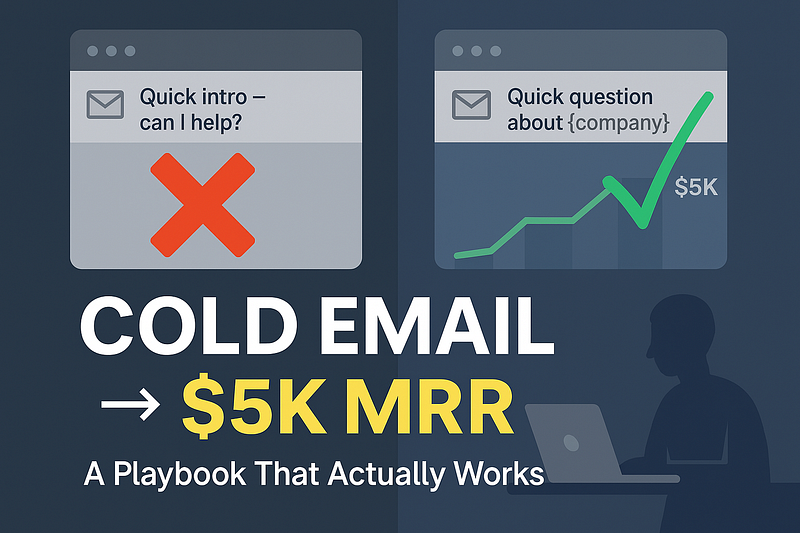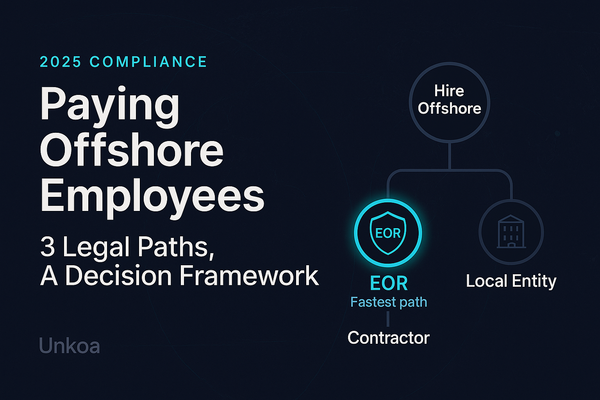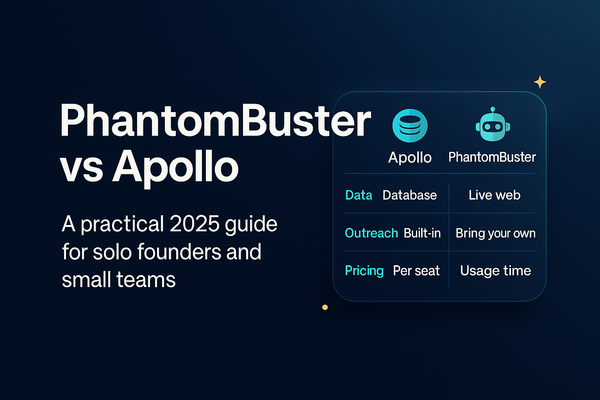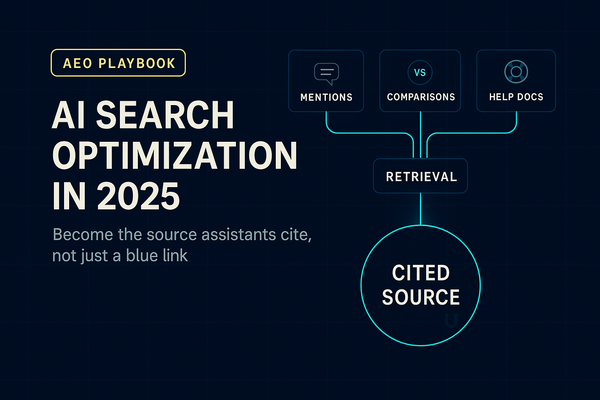Cold Outreach to $5K MRR: The Email Playbook for B2B Service Businesses
If you’re a solo founder or running a small B2B service business, cold email might be your most powerful (and affordable) way to land…

If you’re a solo founder or running a small B2B service business, cold email might be your most powerful (and affordable) way to land clients. You don’t need a huge team or budget to win. Just a laptop, a bit of strategy, and the willingness to personalize your approach.
This article walks you through everything you need to know to hit your first $5K MRR using cold outreach in 2025. We’ll focus on using Apollo.io to find leads and send emails, writing emails that get replies, tracking performance, and building systems that let you scale.
Whether you’re a consultant, freelancer, or small agency — this is your complete guide.
Step 1: Choose the Right Niche and Target Persona
Cold email only works if you send the right message to the right person.
Start by choosing a niche. This just means getting specific about who you want to help. For example:
- SEO services for real estate agents
- Paid ads for eCommerce stores
- Virtual assistant services for busy founders
Why go specific?
- You can speak directly to their problems
- Your message feels more personal
- You stand out from generic emails
Not sure who to target? Think about:
- Past clients or industries you’ve worked in
- Pain points you can solve
- Which types of businesses are likely to pay for help
Also ask:
- What kind of businesses can afford my services?
- Who would I enjoy working with long-term?
- Can I reach them easily through email or LinkedIn?
Look for opportunities where your skills intersect with an underserved niche. For example, if you used to work in logistics and now offer automation services, targeting small freight companies might give you a natural edge.
You don’t need to be perfect here. Pick one micro-niche to test and adjust as you go. You can always pivot based on response.
Step 2: Set Up Apollo.io for Lead Generation
Apollo.io is one of the best tools for outbound sales — especially for solo founders. It lets you:
- Find company and contact info
- Filter by location, industry, title, funding stage, and more
- Export lead lists and send automated email sequences
Create a free account, then:
- Use filters to narrow your search (e.g. “Head of Operations” at logistics companies with 10–100 employees in Canada)
- Build a lead list with verified emails
- Group contacts into lists based on niche or campaign
Use Apollo’s Chrome extension to grab leads from LinkedIn and enrich them with email addresses.
Pro tip: Use Apollo’s “personas” feature to save search templates. You can create profiles like “Marketing Directors in SaaS” and reuse them later.
How many leads do you need? Start with 100 for your first test. Expect to book a few calls and iterate from there.
Step 3: Warm Up Your Email and Set Things Up Properly
Your first emails need to reach the inbox — not the spam folder. That means setting up your domain and warming up your sender reputation.
Checklist:
- Use a custom domain (not @gmail.com)
- Set up SPF, DKIM, and DMARC
- Create a professional signature with your name, title, and website
- Avoid spammy words or sending large images/attachments
- Use a tool like Mailwarm, Instantly, or Apollo’s built-in warm-up feature to gradually ramp up sending volume
Start by sending 10–20 emails per day and increase gradually.
Step 4: Personalize Your Outreach (“Show Me You Know Me”)
The fastest way to stand out is to prove that your email was written for them.
Use the “Show Me You Know Me” approach:
- Start your subject or opening with something specific
- Mention a recent post, press feature, or mutual connection
- Acknowledge something they care about
Examples:
“Congrats on the Series A funding — exciting times!” “Loved your recent post on hiring in retail logistics — curious how you’re scaling that team.”
Even in semi-automated sequences, you can add a line that is manually researched for high-value leads. Apollo allows dynamic fields and personalization tokens to scale this.
This approach dramatically improves your open and reply rates.
Step 5: Write Emails That Get Replies
Here’s a battle-tested structure:
1. Subject Line
- Short, relevant, non-spammy
- 3–7 words max
Try things like:
“{{company}} <> {{your company}}”
“Question about your operations”
“Noticed your job opening”
2. First Line (Personalized Hook)
- Mention something real: a post, press, or product
3. Value Statement
- Show you understand their pain
- Introduce yourself very briefly
- Offer a specific benefit or outcome
4. CTA (Call to Action)
- Ask a simple yes/no question
- Suggest a quick chat without pressure
Example:
“Would it make sense to connect for 10 minutes next week?”
5. Signature
- Keep it clean
- Name + Title + Website + Social (optional)
Step 6: Send Follow-Ups (Respectfully)
Most cold emails get ignored — but many replies come on the 2nd or 3rd touch.
Follow-up strategy:
- Send 3–4 emails spaced 2–4 days apart
- Keep tone casual and polite
- Each follow-up can:
- Reiterate your offer
- Add social proof (e.g. case study)
- Share a resource or ask a new question
Final follow-up can say:
“If now’s not the right time, I totally understand. Feel free to reach out if things change.”
Apollo sequences make this easy to automate while preserving personalization.
Step 7: Track the Right Metrics
You can’t improve what you don’t measure. Key metrics:
Open Rate (goal: 40–60%)
- If low, test subject lines or fix deliverability
Reply Rate (goal: 5–10%)
- If low, improve targeting or email body
Bounce Rate (goal: < 3%)
- If high, verify emails again
Positive Reply Rate (goal: > 3%)
- Not just any reply — actual interest
In Apollo, you can track each sequence step to see which email performs best.
Step 8: A/B Test and Improve
Testing improves results over time. Try changing:
- Subject lines
- First lines
- Value props
- CTAs
- Send times
Only test one variable at a time.
Track which variant gets more opens and replies. Keep the winner, replace the loser, and test again. Continuous improvement will multiply your results.
Step 9: Stay Legal and Respectful
Cold email is legal — if you follow best practices:
- Only email business contacts who’d logically benefit
- Include an easy opt-out or line like: “Let me know if you’d prefer I don’t follow up.”
- Comply with CAN-SPAM, GDPR, and local rules
- Always be polite and human
Spammy, high-volume tactics destroy your sender reputation. Play the long game.
Step 10: Build a Consistent System
Cold outreach works best when you make it a habit:
- Block time daily or weekly for outreach
- Start with 10–20 emails per day
- Review replies and improve your process
- Use templates, snippets, and tools to save time
As you scale, you can:
- Hire a VA to help with research
- Build outbound systems into your CRM
- Use Apollo with Zapier or Notion to track campaigns
Treat outreach like the top of your funnel — not just a one-time tactic.
Cold Email Still Works — If You Do It Right
Most people do cold email wrong: too generic, too spammy, too salesy.
The winners in 2025 are the ones who take a thoughtful approach:
- Target the right niche
- Solve a real problem
- Personalize with care
- Follow up with value
- Optimize every part of the system
You can land clients from scratch. You can build relationships from cold. You can reach $5K MRR (and beyond).
Start small. Send great emails. Track what works. Keep going.
This isn’t a shortcut — it’s a craft.
Now go show them you know them.
Some of the links in this article are affiliate





